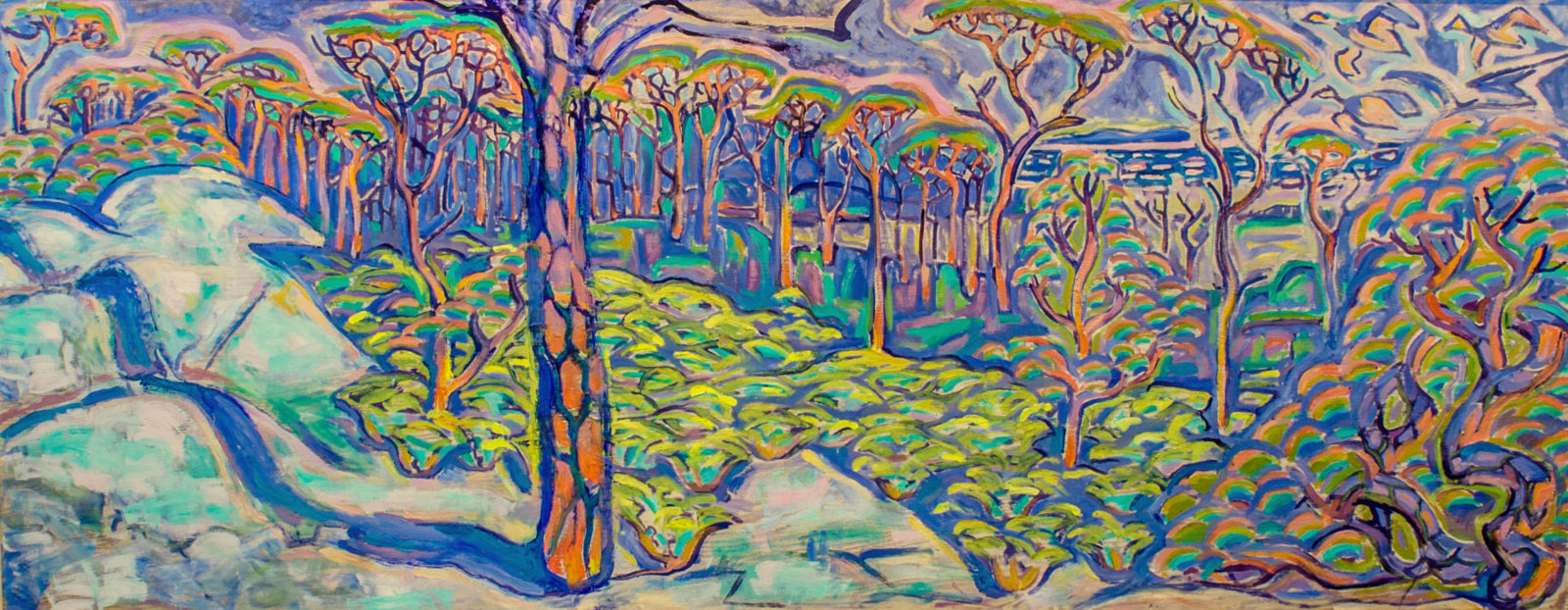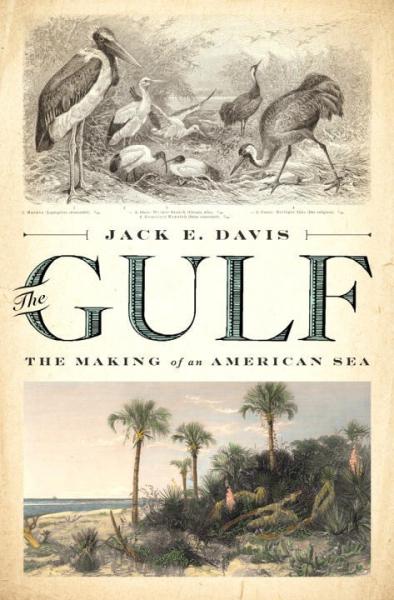Fall 2017
“The Gulf Provided”
Jack E. Davis charts the history of the Gulf of Mexico
Published: September 6, 2017
Last Updated: December 21, 2018

Courtesy of the Walter Anderson Museum of Art
Horn Island, Walter Anderson, circa 1960
Like any good environmental history, Davis begins The Gulf one hundred and fifty million years ago, when one big supercontinent surrounded by one big ocean covered our tiny planet. The gradual breakup of Pangaea produced the body of water that we now call the Gulf of Mexico. Part One of The Gulf sets the stage for Europeans and Native Americans to meet each other in the estuaries of the Gulf coast. Davis recalls an archaeological expedition to southwest Florida in the 1890s that revealed clues about a Native society that ordered itself around the nature of estuaries. Put simply, “the Gulf provided.” Davis shows how, far from becoming exemplars of conquest, sixteenth- and seventeenth-century Spanish explorers like Ponce de León and Hernando de Soto floundered about the Gulf coast because of their inattention to what the estuaries and aborigines had to teach them. It wasn’t until the eighteenth century—after the brothers Pierre Le Moyne, Sieur d’Iberville, and Jean-Baptiste Le Moyne, Sieur de Bienville, established the first permanent French settlements in the vicinity of the Mississippi River—that cartographers started to grasp the unique qualities of the Gulf’s coastal ecology.
By the nineteenth century, President Thomas Jefferson envisioned a westward expansion of the nascent United States that included access to the Gulf of Mexico. This led to the Louisiana Purchase of 1803.“If Jefferson’s West was the land of the nation’s manifest destiny,” Davis writes, “the Gulf was its sea.” In Part Two of The Gulf, Davis follows the growing flow of people to the frontier-like Gulf coast. He charts the course of men like Leonard Destin, who moved from Connecticut to the Florida panhandle during the 1830s. Little did Destin know that the location of his commercial fishing enterprise would become one of the top destinations for Florida beachgoers. Pensacola became the Red Snapper capital of the Gulf, while Fort Myers attracted big-game fishermen looking to catch tarpon. Newspapers and magazines started to describe the Gulf as a “sportsman’s paradise.” Even the former President Theodore Roosevelt couldn’t resist the lure of the Gulf’s fisheries. When he wasn’t fishing, Roosevelt visited a bird refuge that he had established on Breton Sound off the coast of Louisiana. Edward Avery McIlhenny, the famous creator of Tabasco Sauce, joined Roosevelt and other sportsmen and women in protecting migratory birds nesting in Louisiana’s marshes and islands. According to Davis, their efforts represent nothing short of “the birth of conservation on the Gulf.”
“If Jefferson’s West was the land of the nation’s manifest destiny,” Davis writes, “the Gulf was its sea.”
“Waste” became “a sign of success,” as Davis shows through the litany of oil spills that polluted the coastal waters of the Gulf. Offshore oil wells started to go up, first in Baytown, Texas, and then off the coastal parishes of Louisiana. Standard Oil hired the famous documentarian Robert Flaherty to produce the film Louisiana Story. Released in 1948, the message of the film verged on propaganda: “as a steward of civilized progress, the oil industry is equally a steward of a pristine environment and, in particular, the primitive culture that depends on it.” Hollywood followed soon thereafter, with James Stewart playing an oil hunter in the 1953 film Thunder Bay. Davis doesn’t mince words when he describes the impact of the discovery of oil on the people of the coast. “As it pulled taut the economic lifeline,” Davis states, “the amassing petrochemical industry in Texas and Louisiana slackened emotional ties to nature—Gulf nature.”
Davis’s account of the second half of the twentieth century reads like a horror story, albeit one replete with gorgeous beachfront properties and dripping with the riches of oil money. The post–World War II population of Florida grew from three million in 1950 to seven million in 1970, with many of the newcomers moving to the so-called Mangrove Coast in and around St. Petersburg. The tension between environmental protection and economic growth inspired a new generation of conservationists intent upon mitigating the development of high-rise condominiums and artificial beaches, while also raising public awareness about the industrial pollution of the Gulf’s many estuaries. Scientists discovered a “dead zone” in the Gulf, the product of runoff and refuse discharged from the Mississippi River. Scientists also found that Louisiana’s wetlands were disappearing at alarming speeds because the Mississippi River no longer replenished the coast with sediment. Drawing upon the words of the ferryman in Hermann Hesse’s book Siddhartha, Davis warns us that “we cast the shadows of our past and our future over rivers, and upon ourselves.” And who can forget the hurricanes that have so indelibly marked the lives of Gulf residents. Audrey. Betsy. Camille. Katrina. Rita. More than two hundred named and unnamed hurricanes have blown over the waters of the Gulf since 1886.
Walter Anderson was someone who witnessed the transformation of the Gulf during the twentieth century. Davis calls Anderson “the artist of the Gulf of Mexico.” Born in New Orleans in 1903, Anderson settled in Ocean Springs with his family and committed most of his life to painting the flora and fauna of coastal Mississippi. Much of that time was spent on Horn Island, a barrier island that offered Anderson this insight: “If anything was certain on the Gulf, it was the inevitability of change.” Writing in one of his logbooks, Anderson highlighted the word “change” and described it as “magical.” In The Gulf, Davis introduces us to the Gulf’s magic, then shows us how we’ve become masters of disenchantment through oil and gas exploration, overdevelopment, overfishing, and pollution. “In our own eyes,” Davis reminds us, “we are neither insignificant nor ephemeral, and perhaps that’s why we try to dominate nature, to convince ourselves that we are important and in command.” Not exactly a hopeful message.
As someone who has lived most of his life in states along the Gulf coast—Louisiana, Texas, and Florida—I admit my near blindness to the history of changes to the Gulf of Mexico. When I was young, I thought it was normal for the bottoms of my feet to turn black when I played on the beaches of Grand Isle and Galveston. I didn’t know it was oil. I always wanted to stay on the top floor of the highest condominium when my parents took my siblings and me to Gulf Shores. Or better yet, Destin, where I could also get a good deal on a new pair of Nikes at the outlet mall. My father worked for an oil company, which meant that we could go on vacation, and that my parents had money to pay for my siblings and me to have a good education. When I went fishing in the marshes and swamps and lakes of Louisiana, I didn’t contemplate the deteriorating effects of coastal erosion and land subsidence and sea-level rise. Davis gives me—gives all of us—a long view of what we’ve done to disconnect ourselves from nature, as well as hints at what we might do to repair that disconnection in the future. I want to see people reading The Gulf under umbrellas on the Redneck Riviera. I want my fishing buddies to bring a copy of the book with them the next time they take a five-hour boat ride into the Gulf to do some deep-sea fishing. I want to give my father, a retired oilman, a copy of the book for his birthday. Reading The Gulf isn’t just informative—it’s personal, especially for those of us who call the Gulf home.
Michael Pasquier, PhD, is Associate Professor of Religious Studies and History at Louisiana State University. His work on the history and culture of the Mississippi River Delta and Coastal Louisiana has been supported by the American Academy of Arts and Sciences, the National Endowment for the Arts, and the National Endowment for the Humanities.

